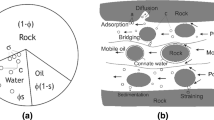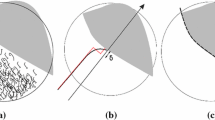In this paper a model is established for unstable seepage flow with polymer concentration and pressure diffusion coupling, considering the effects of polymer molecular diffusion, adsorption, and viscoelasticity of polymer solution in the formation. The factors are close to the actual seepage parameters of the injected reservoir. For the nonlinear adsorption, the combined variable and the analytical iterative method are used to obtain the approximate analytical solution of the model. According to the concentration model, the relationship between concentration and pressure distribution is obtained. Using the model theory curve to fit the well test data, the seepage parameters of the formation are obtained, and the reflection characteristics of the unstable wellbore pressure derivative curve are analyzed.




Similar content being viewed by others
Abbreviations
- D :
-
molecular diffusion coefficient, cm2/s;
- φ :
-
formation porosity, fraction;
- C p :
-
polymer solution concentration, g/cm3;
- C 0 :
-
initial concentration of polymer solution, g/cm3;
- V :
-
apparent flow rate, cm/s;
- q :
-
the adsorption rate, dimensionless
- ac, bc :
-
Langmuir isotherm adsorption coefficient, cm3/g;
- r :
-
radial distance, cm;
- r w :
-
wellbore radius, cm;
- ρ p :
-
polymer solution density, g/cm3;
- \( {\rho}_{\tilde{a}} \) :
-
rock density, g/cm3;
- Q :
-
injection amount of polymer solution, cm3/s;
- h :
-
effective thickness of the formation, cm;
- R k :
-
permeability reduction coefficient, dimensionless;
- R keq :
-
maximum permeability reduction coefficient, dimensionless;
- b k :
-
parameters in the permeability reduction coefficient formula, cm3/g;
- ì p :
-
apparent viscosity of the polymer solution, PaRs;
- μ 0 :
-
zero shear viscosity of the polymer solution, PaRs;
- μ w :
-
water viscosity, PaRs;
- μ aq :
-
viscosity of the polymer solution as it flows through the pores considering the effect of viscoelasticity, PaRs;
- p :
-
pressure, Pa;
- p 0 :
-
initial pressure, Pa;
- t :
-
injection time
- ν :
-
shear rate, s-1;
- ν 1/2 :
-
shear rate corresponding to the average of zero and infinite shear viscosity, s-1;
- P a :
-
Meter viscosity model index, dimensionless;
- μ elas :
-
viscoelastic viscosity of the polymer solution, PaRs;
- N deb :
-
Deborah number, dimensionless;
- C*:
-
coefficient in the viscoelastic expression, dimensionless;
- m :
-
elastic viscosity index, dimensionless;
- tfl, tpr :
-
respectively the relaxation time of the fluid and the characteristic time of the flow, s;
- K :
-
effective permeability of the formation before injection of polymer solution, cm2;
- η :
-
pressure transmission coefficient, cm2/s;
- C t :
-
formation comprehensive compression coefficient, Pa-1;
- D 1 :
-
coefficient of the relationship between the equivalent shear rate and the apparent velocity, dimensionless;
- A1, A2, and A3 :
-
influence coefficients of concentration on viscosity, cm3/g, cm6/g2, cm9/g3.
- D :
-
dimensionless;
- p :
-
polymer solution.
References
J.G. Savins, “Non-Newtonian flow through porous media,” Ind. Eng. Chem., 61(10), 18- 47 (1969).
H.K. Van Pollen and J.R. Jargon, “Steady-state and unsteady-state flow of non-Newtonian fluids through porous media,” Soc. Pet. Eng. J., 9(1), 80-88 (1969).
P.L. Bodor, G.J. Hirasaki, and M.J. Tham, “Mathematical simulation of polymer flooding in complex reservoir,” SPE J.,10, 369-382 (1972).
A.S. Odeh and H.T. Yang, “Flow of non-Newtonian power-law fluids through porous media,” SPE AIME, 19(3), 164-174 (1979).
C. Ikoku and H.J. Ramey, “Wellbore storage and skin effects during the transient flow of non-Newtonian power-law fluids in porous media,” SPE J., 20(1), 25-38 (1980).
O. Lund and C. Ikoku, “Pressure transient behavior of non-Newtonian/Newtonian fluids in composite reservoirs,” SPE J., 21(2), 271-280 (1981).
J. Xu, L. Wang, and K. Zhu, “Pressure behavior for spherical flow in a reservoir of non-Newtonian power-law fluids,” Pet. Sci. Technol., 21, No. 1-2, 133-143 (2003).
T.K. Perkins and O.C. Johnston, “Review of diffusion and dispersion in porous media,” SPE J., 3, 70-84 (1963).
K.H. Coats and B.D. Smith, “Dead end pore volume and dispersion in porous media,” SPE J., 4(1),73-84 (1964).
W.E. Brigham and M.A. Dehghani, “Tracer testing for reservoir description,” J. Pet. Tecnol., 39(5), 519-527 (1987).
H. Guo, S. Cheng et al., “Well test analysis method of composite model by polymer flooding,” Fault-Block Oil Gas Field, 21(4), 504-508 (2014).
O.K. Jensen and B.A. Finlayson, “A numerical technique for tracking sharp fronts in studies tertiary oil-recovery pilots,” SPE, 1(2), 194-208 (1986).
Y. Masuda, “1D simulation of polymer flooding including the viscoelastic effect of polymer solution,” SPE, 7(2), 247-252 (1992).
Acknowledgments
This work is supported by National Natural Science Foundation (No. 51974247, No. 41502311, No. 51874241), Key Laboratory Research Project of Education Department of Shaanxi Province (No. 15JS088), and Shaanxi Basic Research Projects in Natural Sciences (No. 2018JM5054, No. 2019JQ-807).
Author information
Authors and Affiliations
Corresponding author
Additional information
Translated from Khimiya i Tekhnologiya Topliv i Masel, No. 3, pp. 104 — 109, May — June, 2020.
Rights and permissions
About this article
Cite this article
Xie, Q., Xu, J. & Chen, M. Unsteady Pressure Dynamics of Polymer Flooding Reservoirs Considering Concentration Changes. Chem Technol Fuels Oils 56, 481–491 (2020). https://doi.org/10.1007/s10553-020-01159-x
Published:
Issue Date:
DOI: https://doi.org/10.1007/s10553-020-01159-x




